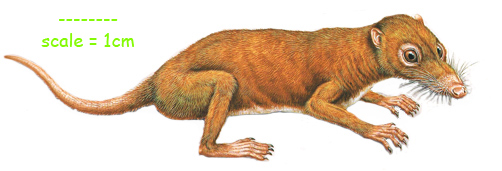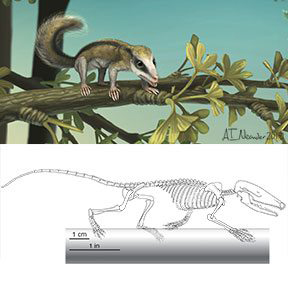Time to Debunk Mammals Totally Dominated by Dinosaurs Myth
Mammals Began to Flourish Before the Dinosaur Extinction
Our congratulations to Elis Newham, a PhD student at the University of Southampton and fellow PhD candidate David Grossnickle (University of Chicago), who have published a scientific paper which effectively debunks the idea that it was only after the dinosaurs became extinct that mammals began to diversify into their myriad forms. Writing in the “Proceedings of the Royal Society – Biology”, the scientists conclude that mammals began to diversify some ten to twenty million years before the End Cretaceous extinction event that saw the demise of the non-avian members of the Dinosauria.
The Dinosaur Extinction
The Popular Misconception that Dinosaur Extinction Led to the Rise of Mammals

An illustration of the Triassic mammal Morganucodon. Mammals lived alongside the Dinosauria for millions of years.
Mammalia Suffered in the End Cretaceous Extinction Event Too
In addition to concluding that the furry mammals were not destined to forever lurk and hide in the shadows whilst the dinosaurs roamed, the scientists have also noted that a number of lineages of mammals became extinct at or around the time of the demise of the dinosaurs. It seems that the mammals too, suffered during the Cretaceous-Palaeogene extinction event, albeit not as much as the dinosaurs.
A Popular Belief but a Mistaken One
Thanks to countless prehistoric animal books, dinosaur documentaries and films, it is a popular belief amongst members of the public that mammalian diversity was suppressed during the Mesozoic, the little, insectivorous mammals could not radiate out and become more diverse as the terrestrial ecosystems were dominated by reptiles, specifically those “terrible lizards” – the dinosaurs. It was only after the dinosaurs died out, that the mammals were able to exploit all those parts of the food chain now vacated and this led to an explosion of different types of mammals during the early part of the Cenozoic.
For models of dinosaurs and prehistoric mammals: Wild Safari Prehistoric World Figures.
Elis Newham, a student in Engineering and the Environment at Southampton University explained:
“The traditional view is that mammals were suppressed during the ‘age of the dinosaurs’ and underwent a rapid diversification immediately following the extinction of the dinosaurs. However, our findings were that therian mammals, the ancestors of most modern mammals [placentals and marsupials], were already diversifying considerably before the extinction event and the event also had a considerably negative impact on mammal diversity.”
Over the Last Few Decades More Fossils of Mammals Have Been Found
Picture credit: University of Chicago (illustration by April Neander)
The picture above shows an illustration and skeletal drawing of the mouse-sized, Middle Jurassic, arboreal mammaliaform Agilodocodon scansorius, whose fossils come from China. Over the last two decades or so, a lot more fossil material has been found relating to early mammals and this evidence indicates that throughout much of the Mesozoic, the ancestors of modern mammals were quite ecological diverse. The research, leading to the naming of A. scansorius was undertaken in part, by scientists from the University of Chicago.
To read more about this study: New Fossil Finds Indicates Widespread Early Mammaliaform Diversity
An Old Theory
Previously, scientists had theorised that as many of the early mammal fossils represented small shrew-sized creatures that were insectivorous, there did not seem to be too much mammalian diversity. However, as more and more early mammal fossils have been discovered, so palaeontologists have became increasingly aware of a much bigger variety of mammals living alongside the dinosaurs.
The researchers examined the teeth (specifically the molars), of hundreds of early mammal specimens in museum collections. The pair found that the mammals that lived in the Late Cretaceous had a wide variety of different tooth shapes, indicating a wide variation in diet. Working out the diets of Late Cretaceous mammals proved vital in the researchers identifying something unexpected regarding the extinction of mammalian genera at the Cretaceous-Palaeogene boundary.
Selective Extinction of Early Mammals
The mass extinction event may not have been the perfect opportunity for the rise of the mammals as many scientists and most members of the public had previously thought. This study suggests that early mammals were affected by a selective extinction at the same time the dinosaurs became extinct. Many mammals with a highly specialised diet died out, the generalists that could adapt to a wide range of food seemed better able to survive the global catastrophe.
Both authors expressed surprise when their data showed that mammals were initially negatively impacted by the mass extinction event.
Lead author of the paper, David Grossnickle remarked:
“I fully expected to see more diverse mammals immediately after the extinction. I wasn’t expecting to see any sort of drop. It didn’t match the traditional view that after the extinction, mammals hit the ground running. It’s part of the reason why I went back to study it further, it seemed wrong.”
Searching for the Reasons Behind Pre-extinction Mammalia Diversification
The reasons behind the mammals’ pre-extinction diversification are unclear. The authors comment on a possible link between the increasing types of mammals and the rise of the angiosperms (flowering plants). Flowering plants might have provided new sources of food for small animals such as seeds, fruit and flowers. An increase in the number of insects as the flowers evolved may have also helped the Mammalia as many of the early mammals were insect eaters.
Back in the spring, Everything Dinosaur published a blog article which looked at some research that suggested seed eating may have helped some types of bird survive the Cretaceous mass extinction event.
To read this article: Seed-eating May Have Helped Birds Survive.
Visit Everything Dinosaur’s website: Everything Dinosaur.


